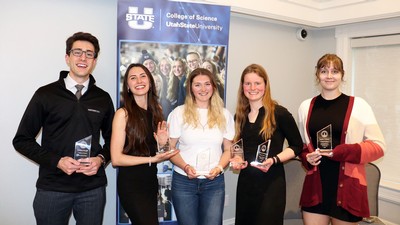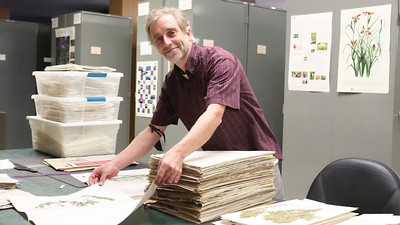Space exploration has captured the imagination of humans since the beginning of time. Cave drawings and Egyptian hieroglyphs detail early civilization’s fascination with the sun, moon, planets and stars. Today, just as in ancient times, space exploration continues to capture the world’s attention, and USU professor Linda Powers has made it her life’s work.
Powers has worked with NASA on several projects throughout her career and has focused her efforts lately looking for life in extreme environments with NASA’s Spaceward Bound program. The program trains the next generation of space explorers by having students and teachers participate in the exploration of scientifically interesting and important aspects of space exploration.
The program is comprised of two expeditions per year. One expedition involves teachers in authentic fieldwork so they can bring that experience back to their classrooms and assist in the development of curriculum related to human exploration of remote and extreme environments. The second expedition enables students at the upper undergraduate and graduate level (including teachers) to participate as crew members in two-week-long, immersive, full-scale simulations of living and working on the Moon and Mars.
In June 2006, the program sent Powers to South America’s Atacama Desert, one of the driest and remote places on Earth. Powers was joined by Shane Rich, a USU graduate working for Powers’ company, MicroBioSytems of Utah. Seven teachers from the United States and several Chilean teachers were chosen to participate in the program, as well as several other scientists who lent their expertise.
The first two days of the trek found the entire group traveling from Santiago, Chile, north to the desert. The flora and fauna of the area quickly changed from lush farmlands to rocks and sand. The first two days were spent at the Yungay Experiment Station in the desert helping the scientists collect and analyze data from nearby sites.
The group spent two weeks in the Atacama, and the highlight of the trip included climbing two volcanoes, the active Lascar and the dormant Licancabur. Since Mars has volcanoes, Powers was interested in analyzing the volcanic ash in the region. She also wanted to look at other sites in the area whose soil composition has been characterized by NASA studies.
With only one 4x4 available, Powers and Rich took along two teachers who drew straws for a spot in the vehicle. The quartet left Yungay and headed deep into the desert collecting soil samples along the way, hoping to catch any glimpse of life in the remote location.
“There is nothing in this desert — no bugs, no mosquitoes, no birds, no ants — nothing,” said Powers.
Using a special instrument created by Powers that uses multispectral intrinsic fluorescence technology that detects low concentrations of microorganisms, the group examined several locations. They took samples from the soil surface to about 3 feet below the soil surface and also collected soil and rock samples to bring back to the United States for analysis.
“If we can figure out what can live in the soil in extreme environments like the Atacama, we can use this as a starting point to figure out what might be, or may have been, living on Mars or Europa, one of Jupiter’s moons,” said Powers.
“Our research group, together with NASA collaborators, has collected soil samples from the North to the South poles to see similarities and differences in organisms that grow in unusual environments. The Atacama Desert is full or minerals and salt, has volcanic activity and is practically at a loss for obvious signs of life. The area is of special interest to scientists because of its similarity to Mars.”
At an altitude of 19,000 feet, the journey to the top of Lascar was treacherous. The small group was a day’s journey into the desert and away from any human contact.
“There was a lot of energy and excitement on this trip,” said Powers. “Collaborating with the teachers was great because they were excited about their experiences and were anxious to share them with their young students.”
One of the teachers, Geoff Hammond, is writing a book about his experience for his first-grade class, and Powers said that fact, in-an-of-itself, makes the trip worth it. His day-by-day account of the expedition can be seen at a project
Web site.
“If we can inspire young, smart minds to be interested in the sciences and math, they will stick with it and want to continue down that path during their education,” said Powers. “These children will be creating the cutting-edge technology of tomorrow, but the education has to start today.”
Powers said the answers they find in the soil samples from the Atacama will provide decisions about where to continue the research. Besides the obvious research component of detecting life on remote planets, the knowledge gained from this technology has tremendous earthbound utility for detecting contaminants in food, water, air and on surfaces.
“We have to continue to fund research to further the technology base on which our economy depends,” said Powers. “Like many of my colleagues, I do it because discovery is exciting. To be one of the first people in the world to know or understand something is a unique and wonderful experience. I want to share this excitement, especially with young students so they are inspired to continue scientific exploration and technology development.”
Powers said the next step is to propose a flight-ready instrument that will detect trace amounts of organisms in remote locations, not unlike the one the group used in the Atacama. Although three to five years away, Powers looks forward to the possibilities.
“Some of the most exciting discoveries we have made in space have been through the unmanned flights to remote planets like Mars,” said Powers.
Powers is the director of the National Center for the Design of Molecular Function at USU and shares appointments in the electrical and computer engineering and biological and irrigation engineering departments. She earned her doctorate from Harvard University.
For more information on NASA’s Spaceward Bound program, visit its
Web site. For more information on Powers, visit her
Web page. For more information on USU’s College of Engineering, visit the college
Web site.
Writer:
Maren Cartwright, 435-797-1355









